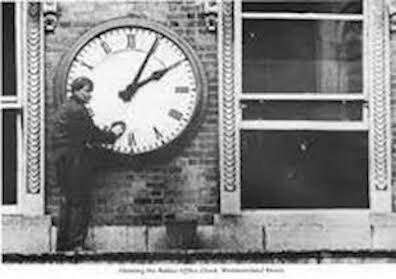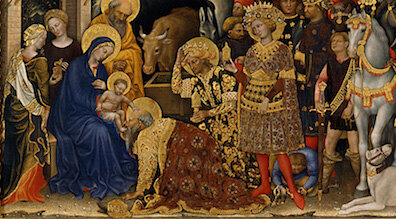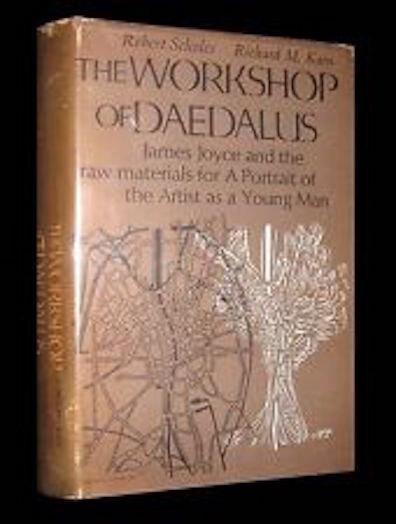Epiphanies
Epiphanies
In Brief
In an earlier novel, Stephen had theorized about literary "epiphanies"—sudden spiritual manifestations, in his words. In Proteus, he mocks these ineffable insights mercilessly. But the concept of the epiphany was fundamental to Joyce's shift from writing poetry to writing prose fiction.
Read More
In Stephen Hero, the protagonist is walking down Eccles Street one evening when he passes a young woman "standing on the steps of one of those brown brick houses which seem the very incarnation of Irish paralysis." A young man is leaning on the railings talking to her, and Stephen hears her softly speaking flirtatious, tempting words. The incident makes him think of "collecting many such moments together in a book of epiphanies. By an epiphany he meant a sudden spiritual manifestation, whether in the vulgarity of speech or of gesture or in a memorable phase of the mind itself. He believed that it was for the man of letters to record these epiphanies with extreme care, seeing that they themselves are the most delicate and evanescent of moments."
Stephen tells a dubious Cranly that even "the clock of the Ballast Office was capable of an epiphany. . . . I will pass it time after time, allude to it, refer to it, catch a glimpse of it. It is only an item in the catalogue of Dublin's street furniture. Then all at once I see it and I know at once what it is: epiphany" (211). He goes on to explain that this is the instant in which the object reveals its quidditas or "whatness" (213)—when, Gifford infers, "the metaphoric potential of an object (or a moment, gesture, phrase, etc.) is realized."
Like Stephen with Cranly, Joyce was telling his companions about these spiritual revelations at the same time that he was writing Stephen Hero. Theodore Spencer's introduction to Stephen Hero notes that Oliver Gogarty mentions the term in his autobiography, As I was Walking down Sackville Street (Reynal & Hitchcock, 1937). Joyce excused himself from a certain gathering and left the room, prompting Gogarty to write, "I don't mind being reported, but to be an unwilling contributor to one of his Epiphanies is irritating. / Probably Fr. Darlington had taught him as an aside in his Latin class—for Joyce knew no Greek—that 'Epiphany' meant 'a showing forth.' So he recorded under 'Epiphany' any showing forth of the mind by which he considered one gave oneself away. / Which of us had endowed him with an 'Epiphany' and sent him to the lavatory to take it down?" (295).
Joyce certainly did think of epiphanies in this way, but he also had religious connotations in mind, since he was beginning to think of his fiction as performing secular functions comparable to the magic of church rituals. Richard Ellmann notes that he was coming to think of Christianity as "a system of metaphors, which as metaphors could claim his fierce allegiance." Literary fiction could be conceived as a kind of transubstantiation, "transmuting the daily bread of experience into the radiant body of eternal life" (A Portrait, 240).
In August 1904 Joyce wrote to a friend that he was writing "a series of epicleti" called Dubliners that would "betray the soul of that hemiplegia or paralysis which many consider a city" (Letters, 55). The term epicleti, taken from the Greek Orthodox liturgy, refers to the moment of transubstantiation. In a letter to his brother Stanislaus, Joyce wrote that "there is a certain resemblance between the mystery of the mass and what I am trying to do." He was trying, he said, to give his readers "a kind of intellectual pleasure or spiritual enjoyment by converting the bread of everyday life into something that has a permanent artistic life of its own" (quoted in Robert Scholes and A. Walton Lizt, eds., Dubliners: Text, Criticism, and Notes, 250).
The Epiphany, in the Christian calendar, is usually celebrated on January 6. The word can refer to the showing of the Christ child to the Magi or, alternatively, to the baptism of Jesus in the River Jordan, during which the "Spirit of God" descended "like a dove" and a voice from heaven said, "This is my beloved Son, in whom I am well pleased" (Matthew 3:16-17). Both stories describe a manifestation of divinity. Joyce did not use the term in quite the same way. His epiphanies were insights into the essential nature of mundane realities, not into godhead. As Gogarty recognized, they could be a manifestation or "showing forth of the mind by which he considered one gave oneself away"—or a moment in which an object revealed something essential about itself. They might give spiritual exaltation to the reader, but only by symbolizing the ways in which Dublin worked—not by symbolizing otherworldly realities. In Proteus Stephen seems to be mocking himself for the air of spiritualism, "deeply deep," that nevertheless clung to the use of terms like epicleti and epiphanies.
The concept of the epiphany has real relevance to Joyce's literary practice. He used the label for at least 40 (and perhaps more than 70) short sketches that he wrote between 1898 and January 1904. Some of these are summarized on a webpage published by The James Joyce Centre at http://jamesjoyce.ie/epiphanies. Although he never followed through on what apparently was his intention to collect them in a book, Joyce did later incorporate some of his epiphanies in Stephen Hero, A Portrait, Dubliners, and Ulysses. A critical book by Robert Scholes and Richard M. Kain, The Workshop of Daedalus: James Joyce and the raw materials for A Portrait of the Artist as a Young Man (Northwestern UP, 1965), details some of these reuses.
Various scholars have used the term to name the effects that conclude stories in Dubliners, in which an image of some human action or thought, or of some object or event, seems to capture the hopelessness of the characters' lives. And for all his embarrassment about his earlier epiphanies, Stephen seems to be heading down the same road. At the end of Aeolus, he tells a vignette about "Dubliners" which concludes with the image of two aged virgins spitting plum seeds off the top of Nelson's pillar.




Source: www.ebay.ie.